Gastropod Characteristics
- Snails & Slugs
- Coiled, asymmetric shell (lost in many)
- Visceral mass (gut, nervous system) becomes twisted 90-180° (reversed in some)
- Muscular, flattened, creeping foot
- radula well developed
- Head with eyes (may be reduced or lost) & tentacles
- Marine, freshwater, and terrestrial
|
|
Subclass Vetigastropoda
Characteristics
- Most primitive group of extant gastropods
- Many (but not all) have excurrent slit or openings in shell
- United by details of microscopic shell structure, gill structure, and molecular evidence
- Most are grazers on algae or on sessile animals such as bryozoans and sponges
- All are marine
|
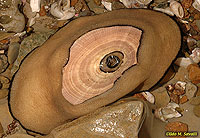
Giant Keyhole Limpet, Megathura crenulata; San Diego, CA
|
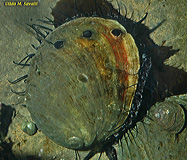
Red Abalone, Haliotis rufescens
|

Turban Snail, Tectus sp.
|
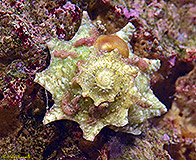
Longspine Star Snail, Lithopoma phoebium
|
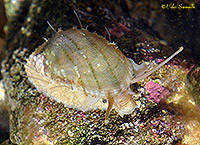
Stomatella Snail, Stomatella sp. (shell is reduced: cannot completely retract into it)
|
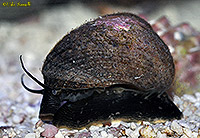
Puppet Margarite, Margarites pupillus
|
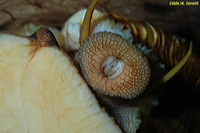
Wavy Turban, Megastrea undosa, closeup of mouth and radula
|
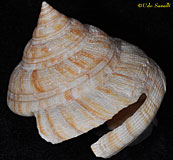
Emperor's Slit Shell, Pleurotomaria hirasei (Order Vetigastropoda); note slit for water outflow
|
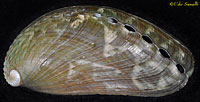
Ass's Ear Abalone Shell, Haliotis asinina (Order Vetigastropoda); note openings for water outflow
|
|
Subclass Patellogastropoda
Characteristics
- True limpets
- All have uncoiled, cone-shaped shells (but lack apical opening of the keyhole limpets in the order Vetigastropoda; the limpet-like shell has also evolved independently in other Gastropod groups)
- Generally use suction to adhere to rocks and other substrates
- Grazers on algae and sea weeds
- Found primarily in the rocky intertidal zone, but some in deep sea
|

Seaweed Limpets, Discurria insessa, feeding on kelp; CA
|
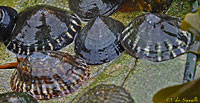
Plate Limpets, Lottia scutum
|
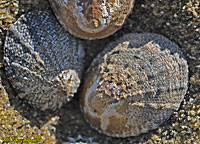
Southern Ribbed Limpets, Lottia austrodigitalis; CA
|
|
Subclass Neritimorpha
Characteristics
- Nerites
- Typical-looking gastropod snails
- Most have coiled shell with a low spire, but some with limpet-like shell
- Operculum present
- Includes marine, fresh water, and a few land snails
|
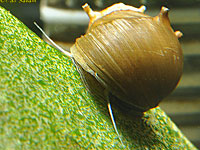
Horned Nerite, Clithon corona; a freshwater species
|
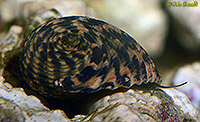
Antillean Nerite, Nerita fulgurans; a marine species
|
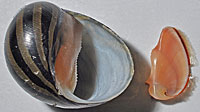
Spotted Nerite shell and operculum, Neritina natalensis
|
|
Subclass Caenogastropoda
Characteristics
- Typical marine snails
- Large and diverse group (60% of all extant gastropods)
- Nearly all have shells (exceptions are some obscure parasites); shells are usually coiled
- Operculum is present
- Characterized by details of radula, heart and ctenidia and molecular data
- Mostly marine, but some fresh water and terrestrial species
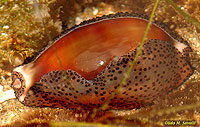
Chestnut Cowry, Cypraea spadicea; San Diego, CA
|

Flamingo Tongues, Cyphoma gibbosum; Belize
|
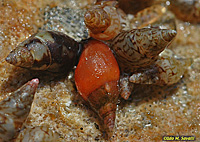
Carinate Dovesnails, Alia carinata
|
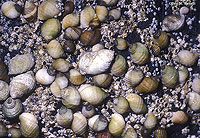
Dogwinkles, Thais lapillus; ME
|

Nassa Mud Snail, Nassarius vibex
|
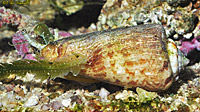
Tiger Sand Conch, Strombus sp.
|
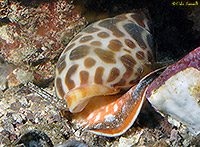
Spiral Babylon Snail, Babylonia spirata
|
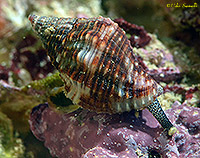
Tinted Cantharus, Gemophos tinctus
|
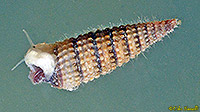
Emerson's Miniature Cerith, Retilaskeya emersonii; collected FL
|
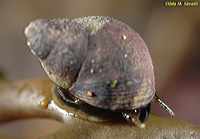
Checkered Periwinkle, Littorina scutulata; CA
|
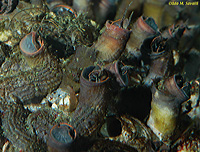
Scaled Worm Snails, Serpulorbis squamigerus; a tube-dwelling snail that captures food using sticky strands of mucus
|
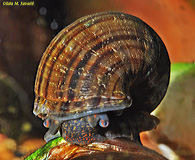
Apple Snail, Pomacea sp., a fresh-water 'prosobranch'
| |
|
Gastropod Shell Diversity (Caenogastropoda)
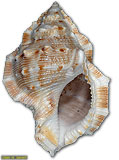
Shell structure of a frogsnail, Bursa sp.
See also labeled photo.
|

Cut shell of a Strawberry Conch, Strombus luhuanus, showing columella
|
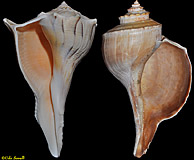
Sinistral vs. dextral shells: the sinistral Perverse Lightning Whelk, Sinistrofulgur perversum, is on the left and the dextral Channel Whelk, Busycon canaliculatum, is on the right (both family Buccinidae)
|
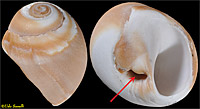
Two views of the shell of Lewis's Moonsnail, Neverita lewisii; arrow indicates the umbilicus at the base of the columella.
|
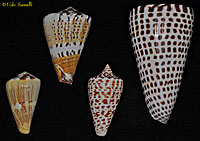
Cone Shells, from left to right: Unid. Cone (Conus sp.), Captains Cone (Conus capitaneus), Alphabet Cone (Spuriconus spurius), Lettered cone (Conus litteratus) (Order Caenogastropoda)
|
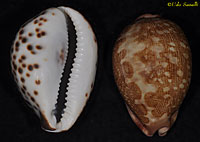
Tiger Cowry, Cypraea tigris, ventral view; Map Cowry, Leporicypraea mappa, dorsal view (Order Caenogastropoda); both are tubular shells
|
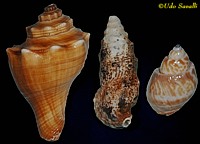
Gastropod Shells, left to right: West Indian fighting conch, Strombus pugilis; Horn snail, Batillaria sp.; and Spiral babylon, Babylonia spiralis (Order Caenogastropoda)
|
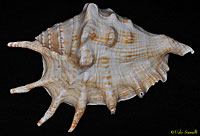
Spider Conch Shell, Lambis lambis (Order Caenogastropoda)
|
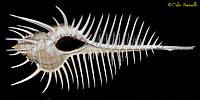
Venus Comb Shell, Murex pecten (Order Caenogastropoda); note operculum
|
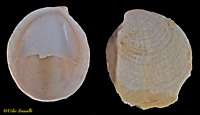
Common Slipper Shells, Crepidula fornicata showing ventral and dorsal views; the shelf is a site of muscle attachment (Order Caenogastropoda)
|

Worm Snail Shell, Tenagodus sp. (Order Caenogastropoda); this shell represents a different family than shown above and thus is an independent evolution of loosely coiled worm-tube-like shells
|
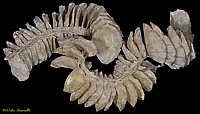
A string of egg cases from a whelk, Busycon sp.? (Order Caenogastropoda)
|
|
Subclass Heterobranchia
A monophyletic group that includes the nudibranchs, pulmonates, and several smaller taxa. Divisions within this group are still being worked out. The various "sea slugs" were formerly placed in a group called the Opisthobranchia, but this group is likely polyphyletic.
|
Order Nudibranchia
|
Characteristics
- Nudibranch sea slugs
- Lack shells
- Lack ctenidia: respire through mantle with aid of cerata and/or external gills
- Many are colorful
|
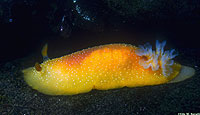
White-spotted Sea Goddess, Doriopsilla albopunctata; CA
|
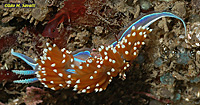
Opalescent Nudibranch, Hermissenda crassicornis; San Diego, CA
|
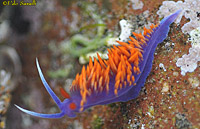
Spanish Shawl, Flabellina iodinea; La Jolla, CA
|
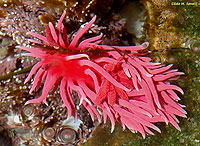
Hopkin's Rose, Hopkinsia rosacea; San Diego, CA
|
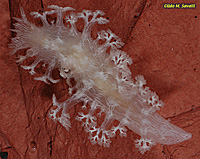
Coral-eating Nudibranch, Tritoniopsis elegans
|
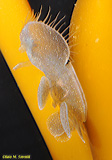
Lion's Mane Nudibranch, Melibe leonina
|
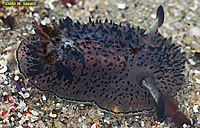
Black-tipped Spiny Doris, Acanthodoris rhodoceras; San Diego, CA
|
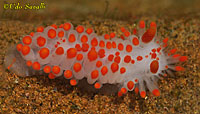
Cockerellís Dorid, Limacia cockerelli; San Diego, CA
|
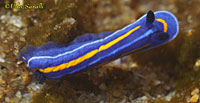
Porter's Chromodorid, Mexichromis porterae; San Diego, CA
|
Clade Euopisthobranchia
|
Characteristics
- Sea slugs that are not nudibranchs, including bubble shells and sea hares
- Formerly considered part of a polyphyletic "Opisthobranchia"
- Mostly united by DNA
- Sea slug-like, but typically with reduced or soft, internal shells
|
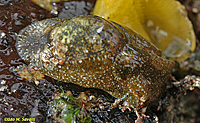
Green Bubble Snail, Haminoea virescens; note reduced shell; San Diego, CA
|
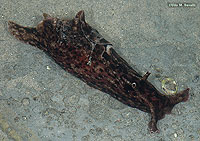
Sea Hare, Aplysia californica, a species with a reduced internal shell; LaJolla, CA
|

Navanax, Navanax inermis; LaJolla, CA
|
Order Pulmonata (Clade Panpulmonata)
|
Characteristics
- Pulmonate snails and their relatives
- Typical land and fresh-water snails and slugs
- Most with coiled shell; lack operculum
- Some (such as land slugs) have lost their shell
- Mantle cavity forms an enclosed "lung" for respiration
- The clade includes some marine species
|
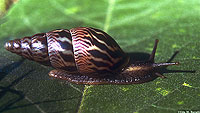
Agate Snail, Limicolaria sp., a large terrestrial species; Kenya
|
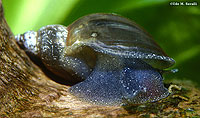
Pond Snail, Lymnaea sp., a small (8 mm) fresh water species.
|
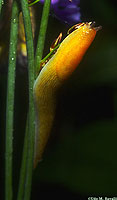
Western Dusky Slug, Arion subfuscus; ME
|
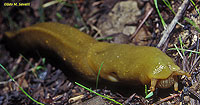
Button's Banana Slug, Ariolimax buttoni; note pneumostome; CA
|
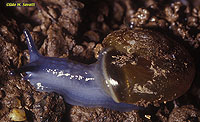
Draparnaud's Glass Snail, Oxychilus draparnaudi; CA
|
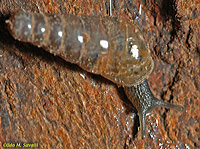
Decollate Snail, Rumina decollata; AZ
|
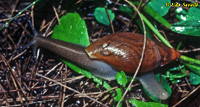
Rosy Wolf Snail, Euglandina rosea; HI
|
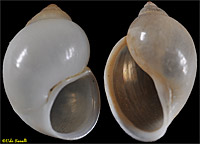
Shells of two pond snails, Lymnaea sp. (dextral) on left; Physa sp. (sinistral) on right
|
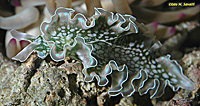
Lettuce Sea Slug, Elysia crispata: although superficially similar to the nudibranchs, this species is more closely related to the pulmonates (although it lacks the air-breathing lung)
|
|
|



























































